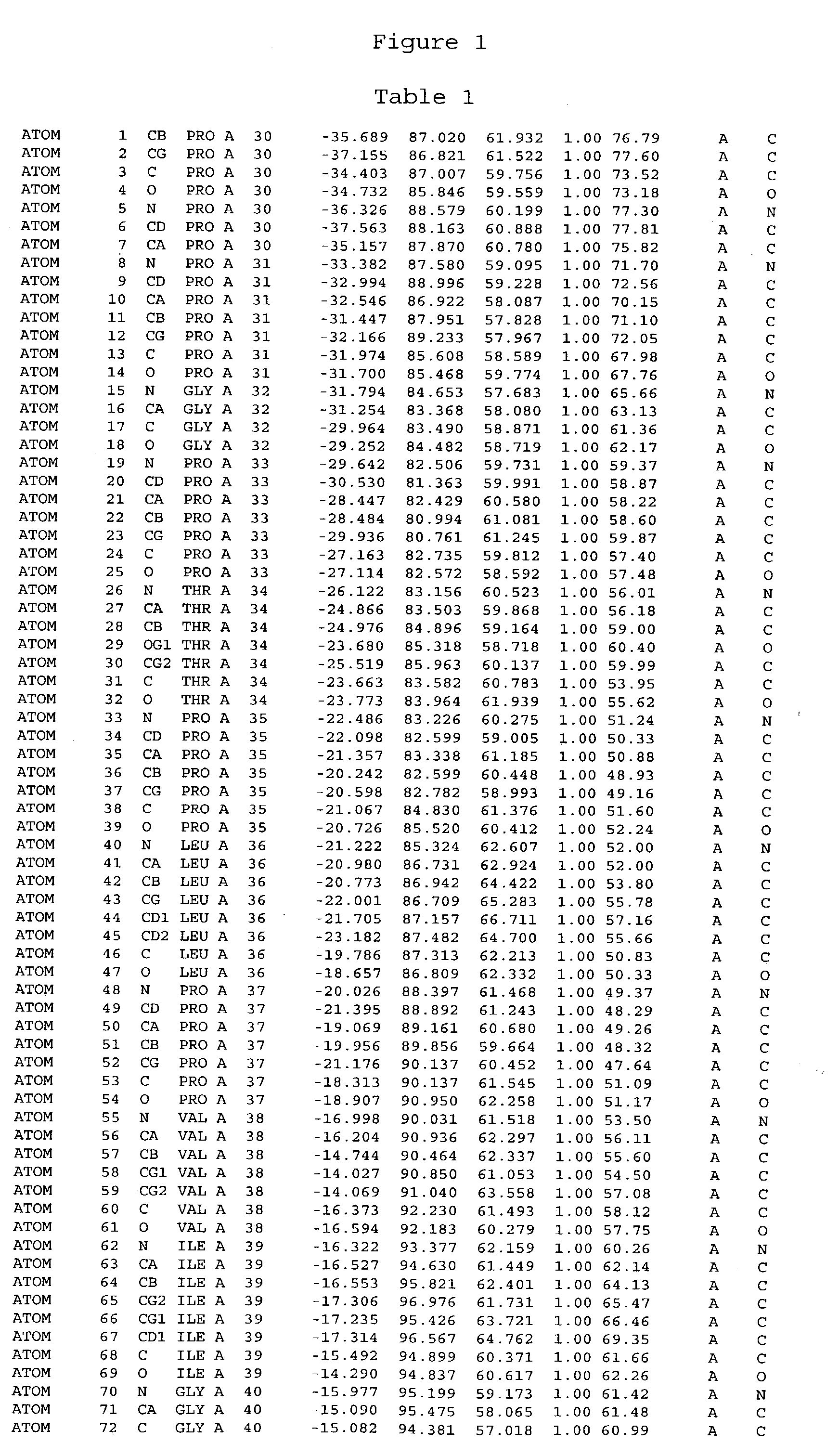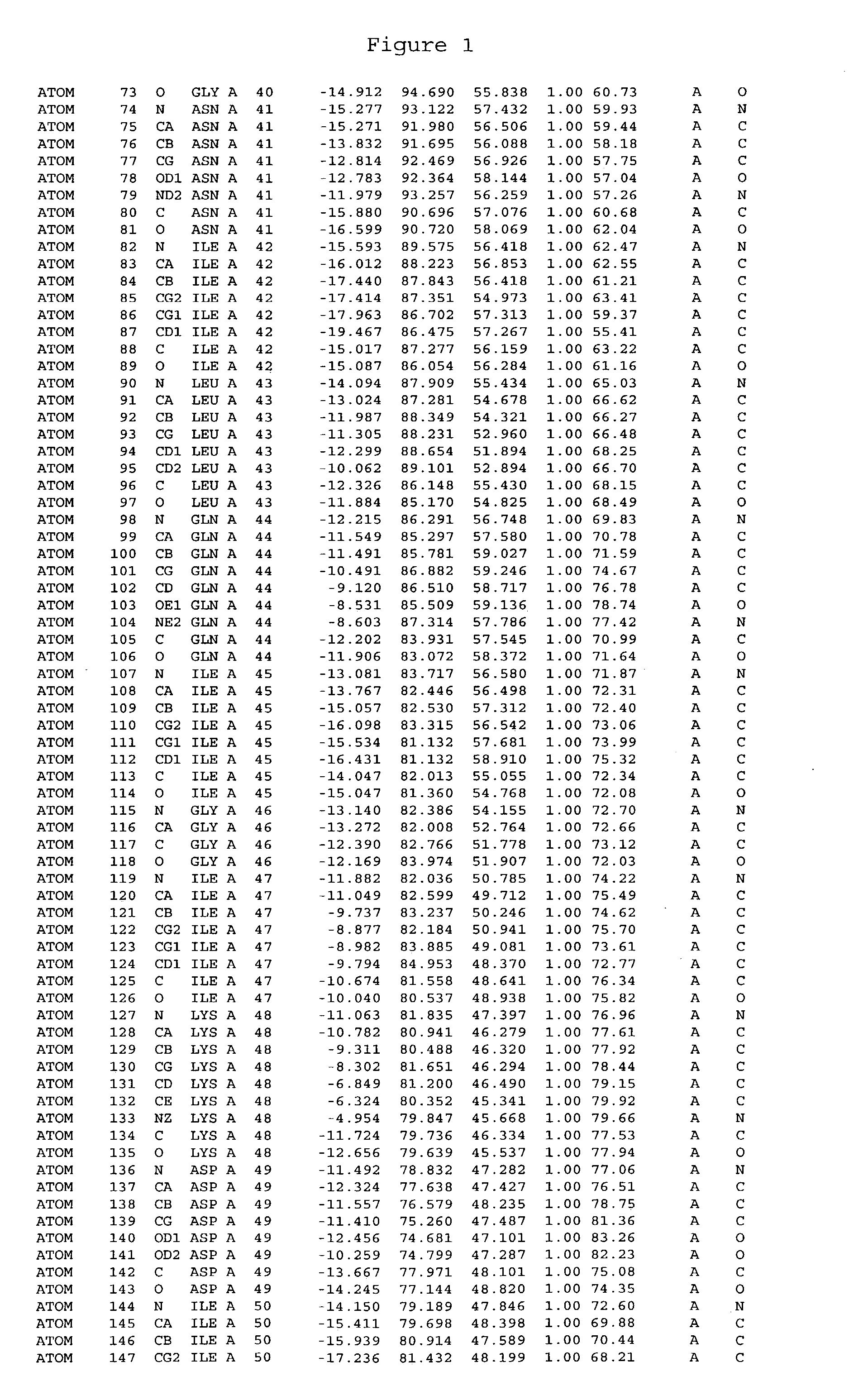Crystals of cytochrome P450 2C9, structures thereof and their use
- Summary
- Abstract
- Description
- Claims
- Application Information
AI Technical Summary
Problems solved by technology
Method used
Image
Examples
example 1
Production of DNA Encoding 2C9 Proteins
[0458] Summary
[0459] Cytochrome P450 2C9 was targeted for crystallisation. Conversion of this intrinsic membranous protein to a more water-soluble form, by removal of the N-terminus trans-membrane domain was performed prior to crystallisation.
[0460] Several N-terminus truncations, largely described in the literature, have been used to produce N-truncated cytochrome P450s (including 2E1, 2D6, 2B1 and others). However, most of these N-terminal truncations failed to produce fully soluble proteins and in most cases, the truncated P450s still remained associated with membranes.
[0461] The membrane anchor domain MDSLVVLVLCLSCLLLLSLWRQSSGRGKL (SEQ ID NO:113) present in 2C9 (residues 2 to 29) was substituted by a short hydrophilic peptide MAKKTSSKGR (SEQ ID NO:114). The introduction of a highly charged polypeptide at the N-terminus of this protein was found to greatly decrease the membrane association of these proteins. It has also been found that the n...
example 2
Expression of 2C9P220 and 2C9-FGloop
[0485] Bacteria Expression
[0486] A single ampicillin resistant colony of XL1 blue cells was grown overnight at 37.degree. C. in Terrific Broth (TB) with shaking to near saturation and used to inoculate fresh TB media. Bacteria were grown to an OD600 nm=0.4 in 1 litre of TB broth containing 100 .mu.g / ml of ampicillin at 37.degree. C. at 185 rpm in 2 litre flask. The haem precursor delta aminolevulinic acid (80 mg / l) was added 30 min prior to induction with 1 mM isopropyl-.beta.-D-thiogalactopyranoside (IPTG) and the temperature lowered to 30.degree. C. The bacterial culture was continued under agitation at 30.degree. C. for 48 to 72 hours.
[0487] (a) Protein Purification
[0488] The cells were pelleted at 10000 g for 10 min and resuspended in a buffer containing 500 mM KPi, pH 7.4, 20% glycerol, 10 mM mercaptoethanol, 0.1% (v / v) of protease inhibitor cocktail (Calbiochem), 10 mM imidazole, 0.01 mg / ml DNase 1 and 5 mM MgSO.sub.4.
[0489] The cells were l...
example 3
Quality Assays
[0497] The quality of the final preparation of proteins from Example 2 was evaluated by:
[0498] (a) SDS Polyacrylamide Gel Electrophoresis.
[0499] This was performed using commercial gels (Nugen) followed by CBB (coomassie brilliant blue) staining according to the manufacturer's instructions. The purity as estimated by scanning a digital image of a gel was estimated to be at least 95%.
[0500] (b) Gel Filtration Chromatography.
[0501] This was done using a Superose 6 HR10-30 column (Pharmacia) was performed to assess the aggregation state. The fractionation range for this column is 5.times.10.sup.3 to 5.times.10.sup.6 Da and is thus well adapted to the resolution of large complexes. The column was eluted at 0.2 ml / min with buffer containing 100 mM KPi, pH 7.4, 300 mM KCl, 20% glycerol, 0.2 mM DTT, 1 mM EDTA. 0.2 ml protein samples at a concentration of approximately 40 mg / ml were used. Absorbance at 280 nm was monitored and the peak was collected and analysed using dynamic ...
PUM
| Property | Measurement | Unit |
|---|---|---|
| Fraction | aaaaa | aaaaa |
| Fraction | aaaaa | aaaaa |
| Fraction | aaaaa | aaaaa |
Abstract
Description
Claims
Application Information
 Login to View More
Login to View More - R&D
- Intellectual Property
- Life Sciences
- Materials
- Tech Scout
- Unparalleled Data Quality
- Higher Quality Content
- 60% Fewer Hallucinations
Browse by: Latest US Patents, China's latest patents, Technical Efficacy Thesaurus, Application Domain, Technology Topic, Popular Technical Reports.
© 2025 PatSnap. All rights reserved.Legal|Privacy policy|Modern Slavery Act Transparency Statement|Sitemap|About US| Contact US: help@patsnap.com



